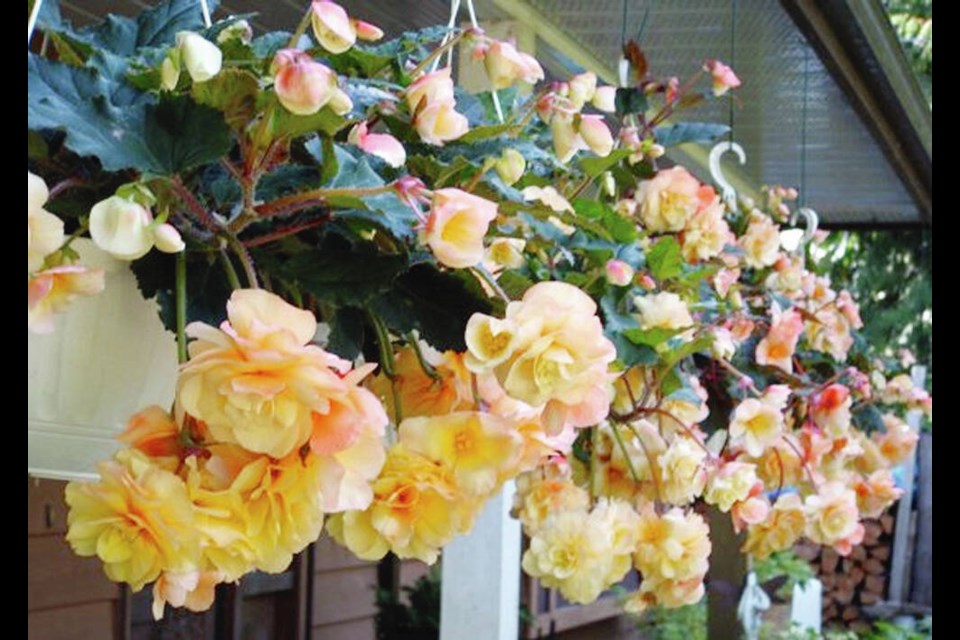Dear Helen: My hanging basket begonias are still flowering, though the plants are beginning to flag a little. At what point should I unpot them and store the tubers?
F.P.
To ensure a fully nourished and plumped tuber to plant next year, keep the plants growing for as long as possible, but as temperatures continue to cool it’s a good idea to reduce watering. This will foster a gradual dying down of the top growth as frosty weather approaches.
With a gradual withdrawal of water, by the time the first light frosts arrive the stems will usually fall away from the tuber, either on their own or at the lightest touch. Avoid breaking the tops away by force. This can damage the tuber’s growth ring.
As frost threatens, I bring the begonia baskets into the shelter of a frost-free place, usually against a house wall under a broad porch roof. Once top growth has been cleared away, I unearth the tubers and lightly brush soil off before storing them, single-layered, in a shallow box with light covering of vermiculite over the tuber tops. An ideal storage temperature range for begonia tubers is between 5 and 10 C.
I check on the tubers a few times over the winter, If the tubers begin to shrivel or feel soft, they need either a cooler temperature or a light spray-misting with water of the vermiculite. Or both.
In March, I bring the box into the house, spray-mist the storage medium and watch for pink nubs of growth on the tubers before potting them and starting the plants back into growth prior to transplanting back into their baskets in late April or in May.
Dear Helen: Late in the summer some of my large kale plants developed a whitish coating on the larger, older leaves. Should leaves in this condition be removed from the plants?
G.L.
There is no need to remove the affected leaves. As long as there is some green colouring in them, they continue working to support the plant. I remove older kale leaves only once they have discoloured and collapsed, to tidy the plants. Those leaves can be safely composted.
New leaves that continue to develop through the fall will not be prone to powdery mildew infection, because of their youth and also because rainy weather offers protection. On wet leaves, fungal spores cannot germinate to spread the disease.
Dear Helen: I was very disappointed in my garlic bulbs this year and, as I’m about to plant again, I’d appreciate tips on best timing for the planting and soil conditions most likely to result in plump, heavy bulbs to harvest next July.
D.H.
The best possible planting site is in full sun, with a soil that is well-drained. Timing is right for planting garlic cloves when the soil has become cool and deeply moist in the fall. This month has brought suitable conditions in most gardens.
Because the garlic will be in the ground through mid-July, with rooting taking place through the fall, it is worthwhile spending time amending the soil to create conditions that will fully nourish the developing roots and spring top growth.
Scratch or lightly fork in lime if the soil is more than slightly acidic. I also incorporate a slow-release, natural-source fertilizer blend and a generous layer (five to eight cm) of high quality compost. And because my soil is light and porous, I also add a shallow layer of coconut fibre (coir) for enhanced moisture retention.
Given a congenial planting site and a robust, fertile soil, garlic planted in this month’s cooling and moderately rainy conditions should yield a satisfying harvest next July.
GARDEN EVENTS
Russell Nursery workshops. Russell Nursery, 1370 Wain Rd. in North Saanich, is offering the following courses. Register by email ([email protected]) or phone (250-656-0384). Specify the workshop and the time you wish to attend. Include your phone number.
* Fall Tree & Shrub Pruning with Noah Alexander, certified arborist with the Municipality of Esquimalt. The workshop will be part theory and part outdoor demonstration. Dress for the weather. Saturday, Oct. 21, at either 10 a.m. or 12:30 p.m. Cost $35.
* Secateur Sharpening with Brian Russell. Learn how to clean and sharpen hand pruners. Saturday, Oct. 28, at 10 a.m. or 1 p.m. Bring one pair of secateurs, preferably ones that can be taken apart, like Felcos. Cost $35.



